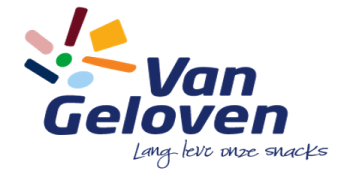Food Manufacturer Van Geloven Implement TXT Demand, Supply Planning and Scheduling Solution as Part of the Journey to Best Practice S&OP

Van Geloven develop and produce Abrand and private label frozen snacks and meal components for the retail and wholesale sector in Europe. There are 6 strong brands within the portfolio: Ad van Geloven, Van Lieshout Snacks, Welten Snacks, The Bourgondier, Mora and Hebro. The company has about 800 employees. Van Geloven are based in the Netherlands. Sales to the Dutch market are done through a Marketing Sales Unit (MSU) in Tilburg and to the Belgium market by a MSU in Mol. Production is executed at four locations: Tilburg, Helmond, Maastricht (all in NL) and Mol (BE).
On request of Van Geloven, EyeOn (Business planning and forecasting Consultants) evaluated the current demand and supply planning process including the planning tools within Van Geloven. EyeOn concluded that the current Van Geloven processes and systems left a lot of room for improvement. The main conclusions:
- Lack of focus in sales forecasting on certain products and customers.
- No focus on demand planning; only a forecast on the lowest level (article-week). Many fluctuations in the demand plan on the short term. Insufficient communication about the demand plan with sales and production.
- Very limited functionality of the current demand planning tool (Excel based).
- Lack of focus in supply planning on certain products. Many fluctuations in the short term plan.
- Supply planning and detailed scheduling is done entirely manually and therefore only 5-8 weeks ahead. Limited long-term capacity planning (including the inventory planning).
- S&OP is only used as an operational planning meeting instead of a tactical one (insufficient focus on future).
- There is a necessity to deploy professional tools for forecasting, demand planning, and supply planning. In some factories there is also a need for a real scheduling tool.
Points of Improvement
From this evaluation, Van Geloven defined five points of improvement to lead to the following deliverables:
- New forecast and demand planning process to:
- provide the right information at the right time
- facilitate the correct alignment between demand (sales) and supply (production).
- Selection of the best fit for purpose forecasting tool, including the implementation and training of user(s).
- New supply planning process for supply planning and scheduling, including:
- correct setting of planning parameters and usage.
- supply planning KPI dashboard.
- Tactical S&OP process that describes roles and responsibilities, standard agenda and standard set of reports.
- Selection of the best fit for purpose supply planning tool, based on the functional requirements regarding supply planning and supply scheduling.
In order to deliver against the five points of improvement Van Geloven embarked on a journey which is still in progress today. A critical part of that journey was the selection and deployment of a Demand and Supply Planning tool. Van Geloven chose TXT.
 With the help of EyeOn, Van Geloven carried a detailed vendor selection process. This started with a long list of potential vendors who responded to an RFI. Following this a slightly shorter list of vendors were asked to present their offerings for the purpose of final shortlisting. Next, Van Geloven issued some ‘Use Cases’ to the remaining vendors.
With the help of EyeOn, Van Geloven carried a detailed vendor selection process. This started with a long list of potential vendors who responded to an RFI. Following this a slightly shorter list of vendors were asked to present their offerings for the purpose of final shortlisting. Next, Van Geloven issued some ‘Use Cases’ to the remaining vendors.
The ‘Use Cases’ detailed specific situations and challenges that Van Geloven dealt with on a day to day basis, vendors had to demonstrate how they would deal with these scenarios. Following the presentation of the ‘Use Cases’ Van Geloven then had site reference visits before final proposals and contract.
Three Critical Areas
So why were TXT selected? TXT were the strongest in three critical areas, functionality, people and budget.
“Specific food industry functionality has to be a given, as do budgetary constraints, but people can make or break a project. What impressed us most about the TXT people was they understood our business, listened and would bring a lot of experience to the project,” says Barbara Van den Berg, the Van Geloven Project Manager.
“In the ‘Use Cases’ they brought solid solutions to the issues we presented them with. It was clear from the outset that we were going to be able to work well together as a team and deliver this project. That is exactly what has happened” continues Van den Berg.
Specific Challenges
To help overcome specific challenges, Van Geloven are implementing TXT’s Demand Planning, Supply Planning and Scheduling solution.
The TXT solution supports Van Geloven in the demand planning process and the generation of high quality forecasts in an environment where up to 40% of demand is promotionally driven. This is further complicated by identical products being sold in different markets with different identifying codes per country, and when on or off promotion. TXT brings all of this together as part of a collaborative process in the short term forecast, and produces a statistical promotional forecast in the longer term where market intelligence is lacking. “Producing a high quality forecast against our volatile promotional demand was a key factor in the success of this project and TXT delivered a solid solution” comments Van den Berg.
The Demand Plan
The Demand plan is an input to the Supply Planning and Scheduling, which is also managed within TXT. The solution generates an optimal plan to meet demand and balance inventory within the real capacity, shelf life and other constraints within a multi-site and multi-level food manufacturing organisation. This includes managing a considerable amount of inter site demand and short term man power in a volatile environment. Plans cover a 26 week operational horizon, a 24 month long term horizon and are produced in a timely manner.
 The software also provides detailed scheduling by day, hour and minute, up to a 12 week horizon (dependent on site). Orders within the multi stage production processes are placed in feasible sequence by the TXT algorithm, accounting for due dates, changeovers, capacity and preceding/ succeeding orders/operations.
The software also provides detailed scheduling by day, hour and minute, up to a 12 week horizon (dependent on site). Orders within the multi stage production processes are placed in feasible sequence by the TXT algorithm, accounting for due dates, changeovers, capacity and preceding/ succeeding orders/operations.
Key Objective
The key objective of the schedule is to meet all planned due dates while minimising down time, costs and respecting all defined constraints. Operators are also defined for each production line giving Van Geloven visibility of labour requirements on a line by line, day by day, hour by hour basis. The TXT solution therefore covers and joins up the whole Supply Chain from long term grouped level forecasts down all the way to production schedules by SKU, by line, by hour and minute.

































